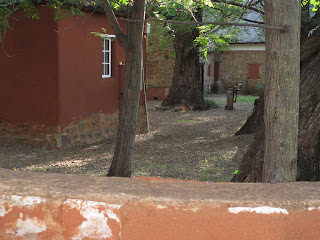I got up and walked around the mission in the early morning and took more pictures. It was very quiet and a little cool (which is really appreciated considering how hot the afternoons are- I was grateful to have the fan for sleeping!), though the sun was fully up. There was a cow bawling. Then I thought I heard a bull too. But no people. Some birds and the crunch of the asphalt.
Looking toward the library
Beautiful desert landscaping. This plant is as big and tall as I am.
This shows the underlying brick construction that has been covered with the red sand/soil and dung mixture- about 2 inches thick.
Looking toward the back of the Moffat home- storage buildings for the mission now used for class and meeting rooms. The trees that have grown are beautiful and wonderful shade in the desert.
Two new buildings in the round house tradition with thatched roof. There are two windows and a chimney in the middle.
After I walked I spent a bit of time in the cemetery. There I found the newer grave of Joseph Wing, the first UCCSA General Secretary. I also found the old graves of multiple children. Missionary babies and young children had a very high mortality rate. There are also graves of former missionaries who had served the mission a very long time and lived a good long life. There were also several soldiers, and the memorial stone for Rev. Bernard Spong's son David who died in a motorcycle accident at 18. The cemetery was old and simple, with both elegant tombstones and graves marked only by piles of stones and some with little cement covers. And then there was the big stone structure for the woman and I believe her 6 children- from ages 3 months to 10 years. A very hard life. And the soldiers- buried far from home and anyone who might remember and visit them. It was very hard for me to see. It felt lonely, especially for those very young lives.
Then I saw the furrow which was dug to irrigate the fields of the Mission and made life here possible. A three mile furrow- a large engineering feat for a time when there were no backhoes, and all supplies for cement would have been hauled hundreds of miles.


















No comments:
Post a Comment